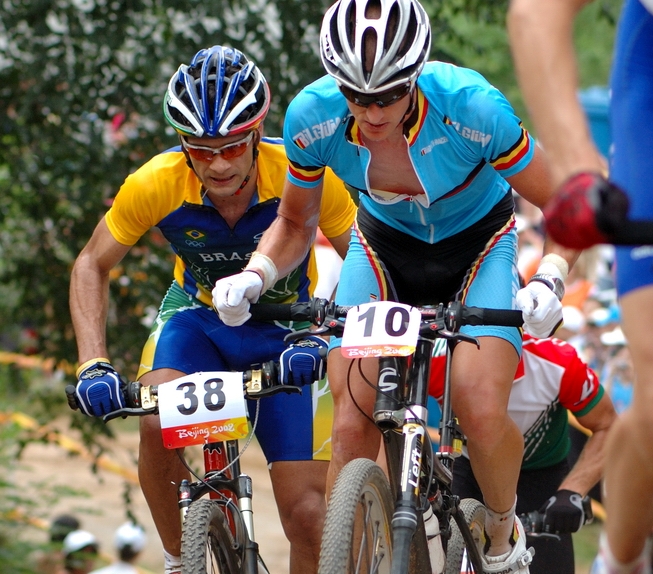Efeito de duas intervenções de treinamento diferentes no desempenho do ciclismo em atletas olímpicos de mountain bike cross country

|
OPEN ACCESS: Artigo disponível/Article available/Artículo disponible - ASSINANTE/SUBSCRIBER: Artigo para Assinante do periódico/Article for Journal Subscriber/Artículo para suscriptores de este periódico - PAY-PER-VIEW: Compre o artigo e leia/Buy the article and read/Compra el artículo y lee - IMAGE: Efeito de duas intervenções de treinamento diferentes no desempenho do ciclismo em atletas olímpicos de mountain bike cross country |
Palavras-chave:
Treinamento Polarizado, Ciclismo Off-Road, XCO, endurance, competiçãoResumo
Para melhorar o desempenho em desportos de resistência, é importante incluir treino de alta e baixa intensidade, mas não existe uma prática universalmente aceite nem evidências científicas claras que permitam afirmações fiáveis sobre a predominância de um método de treino específico. Este ensaio clínico randomizado comparou os efeitos de um modelo de treinamento polarizado (POL) a um modelo de treinamento de baixa intensidade (LIT) nos parâmetros fisiológicos e no desempenho da corrida olímpica cross-country (XCO) de mountain bike em dezoito atletas competitivos de XCO (17,9 ± 3,6 anos). A superioridade de um dos dois métodos não pôde ser demonstrada neste estudo. Os resultados não mostraram diferenças estatisticamente significativas entre POL e LIT, uma vez que ambas as intervenções conduziram a ligeiras melhorias. No entanto, uma pequena tendência para melhores efeitos para POL foi observada na potência do ciclismo durante a corrida (4,4% vs. –2,2%), na dose de 4 mmol/L (6,1% vs. 2,8%) e no limiar de lactato anaeróbico individual (5,1 % vs. 2,3%) e para desempenho aeróbio máximo (4,4% vs. 2,6%), mas não para esforços máximos com duração de 10 a 300 s. Apesar da falta de superioridade significativa neste e em alguns outros estudos, muitos atletas e treinadores preferem o POL porque produz efeitos pelo menos equivalentes e requer menos tempo de treino.
ARK
— Identificador persistente da Edição 2023 OLYMPIKA MAGAZINE - VOLUME 1 ONLINE - Nº. 001: ark:/40019/oly.v1i1
— Identificador persistente deste artigo: ark:/40019/oly.v1i1.6.g16
Referências
(1) Baron R. Aerobic and anaerobic power characteristics of off-road cyclists. Medicine and Science in Sports and Exercise. 2001 Aug;33(8):1387–93.
(2) Impellizzeri FM, Marcora SM. The Physiology of Mountain Biking. Sports Medicine. 2007;37(1):59–71.
(3) Inoue A, Sá Filho AS, Mello FCM, Santos TM. Relationship Between Anaerobic Cycling Tests and Mountain Bike Cross-Country Performance. Journal of Strength and Conditioning Research [Internet]. 2012 Jun 1;26(6):1589–93. Available from: https://journals.lww.com/nsca-jscr/Fulltext/2012/06000/Relationship_Between_Anaerobic_Cycling_Tests
(4) Workload Demands in Mountain Bike Racing. International Journal of Sports Medicine. 2004 May;25(4):294–300.
(5) Union Cycliste Internationale. UCI Cycling Regulations; Part 4; Mountain Bike; Version on 10.06.2021; Union Cycliste Internationale: Aigle, Switzerland, 2021; pp. 1–91.
(6) van Loon LJC, Greenhaff PL, Constantin-Teodosiu D, Saris WHM, Wagenmakers AJM. The effects of increasing exercise intensity on muscle fuel utilisation in humans. The Journal of Physiology. 2001 Oct;536(1):295–304.
(7) Coffey VG, Hawley JA. The Molecular Bases of Training Adaptation. Sports Medicine. 2007;37(9):737–63.
(8) Laursen PB. Training for intense exercise performance: high-intensity or high-volume training? Scandinavian Journal of Medicine & Science in Sports. 2010 Sep 14;20(2):1–10.
(9) Stöggl TL, Sperlich B. The training intensity distribution among well-trained and elite endurance athletes. Frontiers in Physiology. 2015 Oct 27;6(1).
(10) Stöggl TL, Björklund G. High Intensity Interval Training Leads to Greater Improvements in Acute Heart Rate Recovery and Anaerobic Power as High Volume Low
(11) Selles-Perez S, Fernández-Sáez J, Cejuela R. Polarized and Pyramidal Training Intensity Distribution: Relationship with a Half-Ironman Distance Triathlon Competition. J. Sports Sci. Med. 2019; 18, 708–715.
(12) Seiler KS, Kjerland GO. Quantifying training intensity distribution in elite endurance athletes: is there evidence for an “optimal” distribution?. Scandinavian Journal of Medicine and Science in Sports. 2006 Feb;16(1):49–56.
(13) Esteve-Lanao J, San Juan AF, Earnest CP, Foster C, Lucia A. How Do Endurance Runners Actually Train? Relationship with Competition Performance. Medicine & Science in Sports & Exercise [Internet]. 2005;37(3):496–504. Available from: http://www.tradewindsports.net/wp-content/uploads/2014/02/Esteve-Lanao-05-ET-in-Runners-good.pdf
(14) Fiskerstrand A, Seiler KS. Training and performance characteristics among Norwegian International Rowers 1970-2001. Scandinavian Journal of Medicine and Science in Sports. 2004 Oct;14(5):303–10.
(15) Ingham SA, Carter H, Whyte GP, Doust JH. Physiological and Performance Effects of Low- versus Mixed-Intensity Rowing Training. Medicine & Science in Sports & Exercise. 2008 Mar;40(3):579–84.
(16)Laursen PB, Jenkins DG. The Scientific Basis for High-Intensity Interval Training. Sports Medicine. 2002;32(1):53–73.
(17) Billat VL, Flechet B, Petit B, Muriaux G, Koralsztein JP. Interval training at VO2max: effects on aerobic performance and overtraining markers. Medicine & Science in Sports & Exercise. 1999 Jan;31(1):156–63.
(18) Hawley JA, Stepto NK. Adaptations to Training in Endurance Cyclists. Sports Medicine. 2001;31(7):511–20.
(19) Seiler S, Haugen O, Kuffel E. Autonomic Recovery after Exercise in Trained Athletes. Medicine & Science in Sports & Exercise. 2007 Aug;39(8):1366–73.
(20) Muñoz I, Cejuela R, Seiler S, Larumbe E, Esteve-Lanao J. Training-Intensity Distribution During an Ironman Season: Relationship With Competition Performance. International Journal of Sports Physiology and Performance. 2014 Mar;9(2):332–9.
(21) Stöggl T, Sperlich B. Polarized training has greater impact on key endurance variables than threshold, high intensity, or high volume training. Frontiers in Physiology. 2014;5(33).
(22) Miller MC, Validity of using functional threshold power and intermittent power to predict cross-country mountain bike race outcome. J. Sci. Cycl. 2014; 3, 16–20.
(23) Prins L, Terblanche E, Myburgh KH. Field and laboratory correlates of performance in competitive cross-country mountain bikers. Journal of Sports Sciences. 2007 Jun;25(8):927–35.
(24) Novak AR, Bennett KJM, Fransen J, Dascombe BJ. A multidimensional approach to performance prediction in Olympic distance cross-country mountain bikers. Journal of Sports Sciences. 2017 Jan 20;36(1):71–8.
(25) Schneeweiss P, Schellhorn P, Haigis D, Niess A, Martus P, Krauss I. Predictive Ability of a Laboratory Performance Test in Mountain Bike Cross-country Olympic Athletes. International Journal of Sports Medicine. 2019 Apr 1;40(06):397–403.
(26) Ahrend MD, Schneeweiss P, Martus P, Niess AM, Krauss I. Predictive ability of a comprehensive incremental test in mountain bike marathon. BMJ Open Sport & Exercise Medicine. 2018 Jan;4(1):e000293.
(27) Ahrend MD, Schneeweiß P, Theobald U, Nieß AM, Krauß I. Comparison of laboratory parameters of a mountain bike specific performance test and a simulated race performance in the field. Journal of Science and Cycling. 2016 Mar 17;5(1):3–9.
(28) Schneeweiss P, Schellhorn P, Haigis D, Niess A, Martus P, Krauss I. Cycling Performance in Short-term Efforts: Laboratory and Field-Based Data in XCO Athletes. Sports Medicine International Open [Internet]. 2020 Jan 1 [cited 2022 Apr 21];4(1):E19–26. Available from: https://pubmed.ncbi.nlm.nih.gov/32232124/
(29) Crivoi do Carmo E, Barroso R, Leite Prado D, Inoue A, Machado T, Cavinato Cal Abad C, et al. The laboratory-assessed performance predictors of elite cross-country marathon mountain bikers. Kinesiology. 2021;53(2):262–70.
(30) Allen H, Coggan A. Training and Racing with a Power Meter; VeloPress: Boulder, CO, USA, 2010.
(31) Harriss DJ, MacSween A, Atkinson G. Ethical Standards in Sport and Exercise Science Research: 2020 Update. International Journal of Sports Medicine. 2019 Oct 15;40(13).
(32) Gardner A.S, Stephens S, Martin DT, Lawton E, Lee H, Jenkins D. Accuracy of SRM and Power Tap Power Monitoring Systems for Bicycling. Medicine & Science in Sports & Exercise. 2004 Jul;36(7):1252–8.
(33) Paton CD, Hopkins WG. Tests of Cycling Performance. Sports Medicine. 2001;31(7):489–96.
(34) Bachl N, Graham TE, H. Löllgen. Advances in Ergometry. Springer Science & Business Media; 2012.
(35) Roecker K, Striegel H, Dickhuth HH . Heart-Rate Recommendations: Transfer Between Running and Cycling Exercise? International Journal of Sports Medicine. 2003 Apr;24(3):173–8.
(36) Kuipers H, Verstappen F, Keizer H, Geurten P, van Kranenburg G. Variability of Aerobic Performance in the Laboratory and Its Physiologic Correlates. International Journal of Sports Medicine. 1985 Aug;06(04):197–201.
(37) Skinner JS, Mclellan TH. The Transition from Aerobic to Anaerobic Metabolism. Research Quarterly for Exercise and Sport. 1980 Mar;51(1):234–48.
(38) Mader A, Heck H. A Theory of the Metabolic Origin of “Anaerobic Threshold.” International Journal of Sports Medicine. 1986 Jun;07(S 1):S45–65.
(39) Jeffries O, Simmons R, Patterson SD, Waldron M. Functional Threshold Power Is Not Equivalent to Lactate Parameters in Trained Cyclists. Journal of Strength and Conditioning Research. 2019 Jul;1.
(40) Valenzuela PL, Morales JS, Foster C, Lucia A, de la Villa P. Is the Functional Threshold Power a Valid Surrogate of the Lactate Threshold? International Journal of Sports Physiology and Performance. 2018 Nov 1;13(10):1293–8.
(41) Röhrken G, Held S, Donath L. Six Weeks of Polarized Versus Moderate Intensity Distribution: A Pilot Intervention Study. Frontiers in Physiology. 2020 Nov 12;11.
(42)Treff G, Winkert K, Sareban M, Steinacker JM, Becker M, Sperlich B. Eleven-Week Preparation Involving Polarized Intensity Distribution Is Not Superior to Pyramidal Distribution in National Elite Rowers. Frontiers in Physiology. 2017 Aug 2;8.
(43) Neal CM, Hunter AM, Brennan L, O’Sullivan A, Hamilton DL, DeVito G, et al. Six weeks of a polarized training-intensity distribution leads to greater physiological and performance adaptations than a threshold model in trained cyclists. Journal of Applied Physiology. 2013 Feb 15;114(4):461–71.
(44) Rosenblat M.A, Perrotta AS, Vicenzino B. Polarized vs. Threshold Training Intensity Distribution on Endurance Sport Performance: A Systematic Review and Meta-Analysis of Randomized Controlled Trials. J. Strength Cond. Res. 2019; 33, 3491–3500.
(45) Inoue A, Impellizzeri FM, Pires FO, Pompeu FAMS, Deslandes AC, Santos TM. Effects of Sprint versus High-Intensity Aerobic Interval Training on Cross-Country Mountain Biking Performance: A Randomized Controlled Trial. Baur H, editor. PLOS ONE [Internet]. 2016 Jan 20;11(1):e0145298. Available from: https://www.ncbi.nlm.nih.gov/pmc/articles/PMC4720373/
(46) Inoue A, Impellizzeri FM, Pires FO, Pompeu FAMS, Deslandes AC, Santos TM. Effects of Sprint versus High-Intensity Aerobic Interval Training on Cross-Country Mountain Biking Performance: A Randomized Controlled Trial. Baur H, editor. PLOS ONE [Internet]. 2016 Jan 20;11(1):e0145298. Available from: https://www.ncbi.nlm.nih.gov/pmc/articles/PMC4720373/
Nota do Editor: Imagem meramente ilustrativa. Fonte: li yong (https://commons.wikimedia.org/wiki/File:Roel_Paulissen_and_Rubens_Valeriano_Donizeti.jpg), CC BY-SA 2.0 (https://creativecommons.org/licenses/by-sa/2.0), via Wikimedia Commons - Cycling at the 2008 Summer Olympics – Men's cross-country - Roel Paulissen (Belgium - 10) and Rubens Valeriano Donizeti (Brazil - 38)
Publicado
Como Citar
Edição
Secção
ARK
Licença
Direitos de Autor (c) 2023 Patrick Schneeweiss, Philipp Schellhorn, Daniel Haigis, Andreas Michael Niess, Peter Martus, Inga Krauss

Este trabalho encontra-se publicado com a Licença Internacional Creative Commons Atribuição 4.0.






